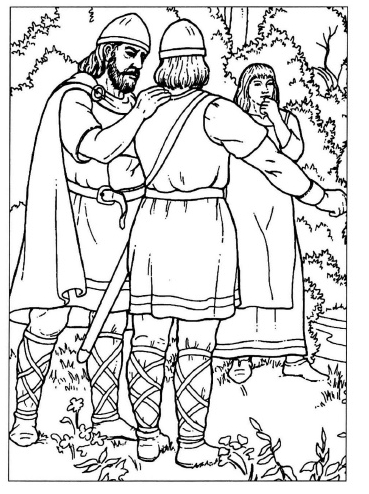
Woodmen in typical garb
Known variously as Widumannas, Woodfolk, Widuingi (Rh. "Wood People"), Widuweri or Sons of Faderda, the Woodmen had long dwelt in Mirkwood, the great forest in Rhovanion since at last the end of the second Age. They were a loose collection of tribes, hunters, Herders and gatherers who lived in or below the trees as extended families, bands, or clans. They were Northmen and thus related to the Beijabar of the Hithaeglir and the foothills of the Grey Mountains. The Éothraim were their distant kin.
Deep in the shadows of Mirkwood's western eaves, a small population of Northmen preserved the traditional lifestyle of their remote ancestors. The Woodmen had had little contact in the past with either Dwarves or Dúnedain, and their culture reflected this fact. their limited communication with the Wood-elves had given them the knowledge they needed to build towns upon great platforms in the trees (the word " flet" was one of the few words which had passed from the Woodman tongue into the more widely spoken Westron). This architectural innovation had provided them a measure of security from the dangers of Mirkwood and given their culture the opportunity to flourish. In the mid third the Men of Mirkwood begun to communicate with their Northman cousins, though a wall of isolation still prevented closer friendship with them. The Woodmen were friendly to the wizard Radagast the Brown, who had helped them with his knowledge of herb-lore many times in the past, for the most part, the Woodmen lived off the bounty of Mirkwood. They hunted deer and small game, herded Sheep and Tree-goats and collected forage for edible plants. Their activities were predominantly confined to the edges of the woods. They lived in terror of Mirkwood's black heart, the section of the forest where no sun reached the earth. They hated the Orcs of Dol Guldur and laid deadly ambushes for any who passed into or came from their territory. The Woodmen lived in scattered villages high in the trees or near to the woods of the foothills of the Misty Mountains. Each village was a virtually independent community, responsible for its own welfare. Only rarely did the Woodmen-towns take counsel with one another, usually in times of great crisis. At these instances, the villages relied upon the authority of an All-Thane (W."Aladegan"), a high chief who was elected leader by the consensus of the local chiefs.Traditionally, the Allthane was the chief of Woodmen-town, the largest settlement of Woodmen in Mirkwood. The Allthane, Waulfa, had been more ambitious than his predecessors. He had established an annual autumn fair at Woodman-town, and his efforts had met with great success. For all their isolation, one might have expected the Woodmen to be completely ignorant of long-distance trade. However, the influx of Northmen into the Anduin Vales had shown the Woodmen the value of an advanced economy. They had begun to trade, mainly at the urging of Waulfa, with the Beiabarnae and the Elves of Mirkwood. They offered their surplus products, primarily hides, furs, herbs, and leather, in exchange for the finished products the more urban Northmen had to offer. However, the trade still remained limited in scale, restricted to a few adventuresome Woodmen who risked the dangers of exposure outside the protection of the forest. The Woodmen, out of fear for their safety, did not invite strangers into their villages. They may have aided a traveler in need, but they did not see the necessity to open their homes to a steady flow of strangers, especially with the spies of the Necromancer about.
Tribes
- Adali
- Corsechings
- Fadirings
- Gudumari
- Herimardi
- Mardugardi
- Melburgi
- Meroagings
- Olphangings
- Seretheud
- Unsippi
The Woodmen at later Times
In the early Fourth Age most Woodman families owed allegiance to one of three major groups: The Tribe of Olphango, The Tribe of Meroaga and the Tribe of Corsechar.
Woodmen in TA 1650
- Political Organization: Tribal.
- Rulers: Wulfila of Vidubaurg, All-Thane (High Chief).
- Administrative Organization: Each tribe is independent, usually electing its own chieftain based on merit. For issues affecting the entire Wood, the chieftains seek counsel with the All-Thane, the most influential of their number. Land is held in common by the tribe, its use dictated by the chief.
- Population: 8,000 Northmen.
- Military: 650 Warriors, led by local chieftains.
- Products: Lumber, hides, nuts, carved wooden boxes.
- Symbol: None
Speculations
Widulingas seems to be derived from old Frankish Widu (wood) and -ing (descendant).Widufiras from Widu and Anglo-Saxon firas (men).Faedred is probably derived from the old Frankish personal name Faderad or Ferdirad or the anglo saxon "faedred", "fathered".
Proper old Frankish forms of Widulingas and Widufiras could be Widuingi or Widungs and Widuveri or Widuweres
Woodmen of Renown
Second Age
Caro Faderda
TA 1640
Ansreik Balthila Barca Barnbinevia Berubaur Beruvacar Bragia Helporeik of Mathleisbaurg Gailasvina Gundramma Marhrreik Wodgisla Raiasvintha Sutiswulf Wulfila of Vidubaurg
TA 2940- 3018
Baldio Benegar Benevacer Berga Bernebrun Beuvacer Broco Brunebeno Burgo Gisolph Gorm Odoacer Sculdilo Olphilo Olpho
Fourth Age
Corsechar Durtheniel Erchwed Gerohar Meroaga Olphango Swelte Turchelin
Woodmen Settlements in TA 1650
- Thingastathbaurg
- Triugardabaurg
- Vidubaurg
- Viduvairibaurg
- Ceber Fanuin
- Erkna-stainae
- Mathleisbaurg
- Sairthiudabaurg
- Sarn Lothduin
- Wulfgeisistath
- Viduvosbaurg
Woodmen Settlements in TA 3019
- Audaghaim
- Mountain Hall
- Rhosgobel
- Woodland Hall
- Woodmen-Town
References
- Retrieved from [Realms of Arda]; original reference: [ICE MERP 2000]
- The One Ring Roleplaying: Adventurer's Companion
